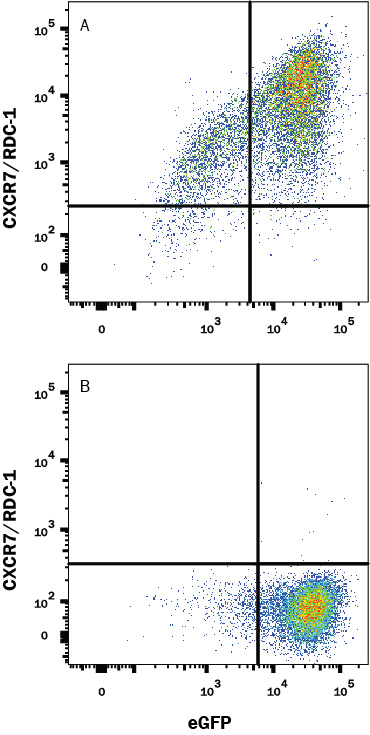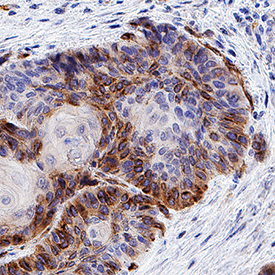Human CXCR7/RDC-1 Antibody Summary
Accession # P25106
Applications
Please Note: Optimal dilutions should be determined by each laboratory for each application. General Protocols are available in the Technical Information section on our website.
Scientific Data
 View Larger
View Larger
Detection of CXCR7/RDC-1 in HEK293 Human Cell Line Transfected with Human CXCR7/RDC-1 and eGFP by Flow Cytometry. HEK293 human embryonic kidney cell line transfected with (A) human CXCR7/RDC-1 or (B) irrelevant transfectants and eGFP was stained with Mouse Anti-Human CXCR7/RDC-1 Monoclonal Antibody (Catalog # MAB42273R) followed by APC-conjugated Anti-Mouse IgG Secondary Antibody (Catalog # F0101B). Quadrant markers were set based on control antibody staining (Catalog # MAB002). View our protocol for Staining Membrane-associated Proteins.
 View Larger
View Larger
CXCR7/RDC‑1 in Human Squamous Cell Carcinoma. CXCR7/RDC-1 was detected in immersion fixed paraffin-embedded sections of human squamous cell carcinoma using Mouse Anti-Human CXCR7/RDC-1 Monoclonal Antibody (Catalog # MAB42273R) at 5 µg/mL for 1 hour at room temperature followed by incubation with the Anti-Mouse IgG VisUCyte™ HRP Polymer Antibody (Catalog # VC001). Tissue was stained using DAB (brown) and counterstained with hematoxylin (blue). Specific staining was localized to cell surfaces and cytoplasm. View our protocol for IHC Staining with VisUCyte HRP Polymer Detection Reagents.
Reconstitution Calculator
Preparation and Storage
- 12 months from date of receipt, -20 to -70 °C as supplied.
- 1 month, 2 to 8 °C under sterile conditions after reconstitution.
- 6 months, -20 to -70 °C under sterile conditions after reconstitution.
Background: CXCR7/RDC-1
The G protein-coupled receptor, RDC1, belongs to a subgroup of chemokine receptors and has been designated CXCR7. CXCR7 can bind with high-affinity to CXCL12/SDF-1 and CXCL11/I‑TAC. It is also a co-receptor for several HIV and SIV strains. In their N-termini and extracellular loops 1, 2, and 3, human and mouse CXCR7 share 84%, 100%, 96%, and 86% amino acid sequence identity, respectively. Reports of mRNA levels and/or protein expression (as assessed using anti-CXCR7, clone 9C4) (J. Biol. Chem. 2005, 280(42):35760, J. Immunol. 2006, 176(4):2197) indicate that CXCR7 occurs on a wide variety of tissues and cells including monocytes, B cells, T cells and mature dendritic cells. In contrast, based on ligand binding analysis and receptor level (as assessed using anti-CXCR7, clone 11G8), surface expression of CXCR7 was reported to be restricted to tumor cells, activated endothelial cells, fetal liver cells, and few other cell types (J. Exp. Med. 2006, 203(9):2201). The basis of these inconsistent observations is not known but may be attributed to cell context and the use of different antibodies that may recognize different epitopes.
Product Datasheets
FAQs
No product specific FAQs exist for this product, however you may
View all Antibody FAQsReviews for Human CXCR7/RDC-1 Antibody
There are currently no reviews for this product. Be the first to review Human CXCR7/RDC-1 Antibody and earn rewards!
Have you used Human CXCR7/RDC-1 Antibody?
Submit a review and receive an Amazon gift card.
$25/€18/£15/$25CAN/¥75 Yuan/¥2500 Yen for a review with an image
$10/€7/£6/$10 CAD/¥70 Yuan/¥1110 Yen for a review without an image


